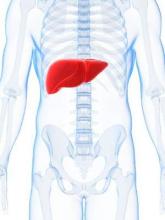SAN DIEGO – Clear resection margins, no matter how narrow, are associated with increased survival when surgeons excise liver tumors from metastatic colorectal cancer (MCRC).
When colorectal cancer metastasizes to the liver, tumor resection can be a safe intervention that improves long-term survival and contributes to cure. Previous studies have shown that any amount of negative margin had a positive impact on overall survival, but these smaller studies were hampered by lack of uniformity in definitions and in surgical technique. Additionally, new developments in chemotherapy have changed the treatment course and overall survival for those with MCRC and need to be taken into account.
Dr. Michael D’Angelica and his colleagues at Memorial Sloan Kettering Cancer Center, New York, presented findings from a large, single-center cohort of patients with MCRC at the annual meeting of the American Surgical Association. The aims of the study, he said, were to analyze the association between margin width of tumor resection and survival in an updated cohort receiving modern therapies, and to account for potentially confounding factors.
The study included 2,368 patients who had hepatic resection for MCRC from 1992 to 2012; patients had the same liver transection method and had high-resolution microscopic pathologic measurement of tumor margins, which allowed submillimeter assessment of margin width. Dr. D’Angelica said that the study captured clinical and patient characteristics, including the number and size of tumors, clinical risk scores, and the presence of any extrahepatic disease.
About half of all patients (n = 1,191) had tumor margins between 1 and 9 mm; one-third (n = 765) had tumor margins of 10 mm or more. One in 10 patients (n = 245) had positive tumor margins, while the remaining 7% (n = 160) had negative tumor margins of 0.9 mm or less.
The study cohort was followed for a median 55 months; a significant relationship between margin width and survival emerged, with all negative margins widths being associated with significantly longer overall survival than the survival curve for those with positive margins (P < .01). This was true even for the narrowest margin widths. Factors associated with submillimeter tumor margins included tumor ablation, having more than three tumors, or tumor size over 5 cm.
Survival differences seen with submillimeter differences in tumor margin are likely attributable to currently unknown tumor growth properties, rather than actual margin width, Dr. D’Angelica said. In response to a question from Dr. Jean-Nicolas Vauthey of MD Anderson Cancer Center, Houston, Dr. D’Angelica speculated that the future of treating MCRC may rely on microscopic determination of tumor growth patterns, as well as better understanding of underlying gene patterns.
“Negative histologic margins, at all widths, including submillimeter margins, are independently associated with improved overall survival,” said Dr. D’Angelica. A significant difference was seen between patients with positive margins and any negative margin width, and between patients with submillimeter vs. 1 mm or greater margins. Beyond 1 mm, however, increasing margins widths were not associated with increased survival benefit.
Dr. D’Angelica noted that surgeons should not fear that a surgery with anticipated close margins would not benefit the patient, since any amount of clear margin confers a survival benefit. Wide margins, however, should be attempted when the approach is safe and feasible because it is the best-known technical approach to ensure a negative tumor margin. Very narrow margins, he noted, are probably a marker for an unknown biological factor rather than a true reflection of surgical technique.
The authors reported no disclosures.
The complete manuscript of this study and its presentation at the American Surgical Association’s 135th Annual Meeting, April 2015, in San Diego, California, are anticipated to be published in the Annals of Surgery pending editorial review.


